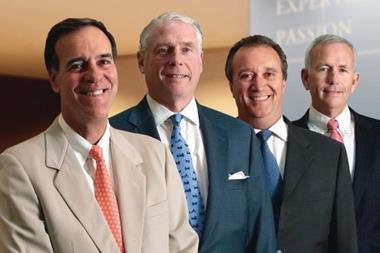The people who earn a living predicting risk are worriers at the best of times, writes Lauren MacGillivray. But after the thrashing the economy has taken, the experts looking at the risk landscape for 2009 are grimmer than ever.
“The degree to which the world has lost confidence in its institutions and systems is serious,” writes Klaus Schwab, founder and executive chairman of the World Economic Forum, in the report Global Risks 2009, released earlier this month. “Without confidence we could face a protracted and potentially calamitous, downward spiral.”
Obviously, the economy is expected to be the biggest risk in the coming year. After a crisis in the US subprime mortgage market morphed into a worldwide credit shortage in the first half of last year, many advanced economies spiralled into recession in the second half of 2008. This had a knock-on effect for emerging markets that has, in turn, increased the chance of a slowdown or a contraction for many economies this year (see chart, above).
While this crisis has taken centre stage, other risks related to the environment, geopolitics, health and technology cannot be ignored. The report warns that global risks are interlinked so it’s dangerous to forget other potential problems when dealing with a current one.
“The events of 2008 underscored the importance of two major ideas: global risks can only be understood when explored in the context of their interlinkages with other risks and no one group acting alone can mitigate them effectively.”
Here we look at Global Risks 2009, published in collaboration with Marsh, Swiss Re, Zurich, the Wharton School Risk Centre and Citigroup at a time when “markets remain volatile, liquidity hasn’t returned, unemployment is rising, and consumer and business confidence has fallen to record lows”. It sheds some light on what the dangers are, and what business leaders can do to mitigate risk.
Biggest risks
Deteriorating fiscal positions, asset price collapses and China’s slowing economy are considered the major economic risks this year (see risk barometer, right).
The UK, with the USA, France, Italy, Spain and Australia, were singled out as running high deficits in the World Economic Forum report.
“Massive government spending in support of financial institutions and growth are threatening to worsen fiscal positions that are already precarious in many countries. The convergence of this decline with rising health and pension costs in industrialised economies ... will place further fiscal pressure on governments,” says the report.
Fiscal risk is also linked to retrenchment from globalisation, a fall in the US dollar, a rise in chronic diseases, underinvestment in public infrastructure, and further asset drops.
Prices for assets such as housing, equities and corporate bonds have plummeted – falls that could easily spread to other asset classes. Deflation, caused by financial uncertainty, falling asset prices, poor credit conditions, weak demand and rising unemployment, is also a key concern.
Meanwhile, China is facing a loss of exports because of the recession in the USA and other markets, and growth could drop to 6% or below. However, the country’s domestic market could help compensate for this (last November, the World Bank predicted that China would still achieve 7.5% growth this year).
It used to be claimed that emerging markets were not directly linked to developed economies. But the credit crunch has proved otherwise.
Longer-term risks such as climate change continue to be a big issue. Weather events, energy and worsening water quality and availability are the main concerns, but resource challenges are also linked to food security, geopolitical and health risks.
For the first time, the report lists “governance gaps” as a threat. This refers to the absence of effective and inclusive governance on global issues such as financial stability, trade, climate change, water and security.
Meanwhile, health-related risks including chronic and infectious disease, as well as pandemics, continue to be serious dangers.
In terms of geopolitics, Russia’s shaky agreement with Ukraine and the EU over its gas supply is a stark example of how quickly risks can spring up. Hundreds of thousands of Europeans were left without gas earlier this month when Russia cut off the supply after a contractual dispute with Ukraine.
There are also risks from tensions between Israel and the Palestinian territories, and in Iraq and Afghanistan. Parts of Latin America, and African countries including Somalia, Sudan and Zimbabwe, face enormous political challenges.
Insurers in emerging markets
Swiss Re warned last month that the downturn would hurt insurers in emerging markets. Last year, premiums in the non-life sector in emerging economies grew 11.6% to $199bn (£136bn). But Swiss Re estimates that growth could slip to just 3% this year.
However, interest in these economies is not waning – so far. Earlier this month, for example, Pierre Ozendo, Swiss Re’s head of Americas operations, said Swiss Re wanted growth in Eastern Europe and Asia, in particular China.
Meanwhile, last October, Lockton received its wholly-owned foreign enterprise insurance broking licence, which allows it to operate in China. And with a £15m cash injection from its shareholders announced earlier this month, the broker is looking to develop the business further, including setting up offices in China and Dubai.
Aon has had a joint venture in China with state-owned China National Cereals, Oils, & Foodstuffs Import & Export Corporation (Cofco) since 2003.
Aon-Cofco started in Shanghai and is now the largest international broker in the Chinese market, with more than 150 staff and five offices.
Fang Fi, who runs Aon Global’s China desk, admits the biggest challenge for Aon-Cofco this year will be maintaining its growth. But she adds: “Even though [China’s] growth is slower compared with the two-digit growth of the previous 10 years, it’s still one of the highest growing countries in the world.
“Considering the international economic situation, it’s definitely worth considering investment in China if the company has a long-term strategic plan and cash.
“The risk management team of one of the investment banks recently contacted me on insurance services in Asia, saying they are busy with the China market as it’s the most exciting place.”
Oliver Peterken, chief risk officer for Aspen Re, adds: “By historical standards in the western world, 6% is a pretty good growth rate. It’s just that in the past China has had an exceptional growth rate.
“It is also experiencing a phenomenon we’ve not seen in the western world for the past 200 years – a shift from a largely agricultural to an industrial economy.
“Even at 6%, China is continuing to create opportunities for foreign businesses.”
The forum report says China’s effect on global growth must be considered, however. It says: “Given the importance of China ... and its net-creditor position mainly with respect to the US, a slowdown to 6% or below would have a significant impact on the global economy.”
The year ahead for governments and regulators – and the firms they oversee
The financial crisis has highlighted the need for better early warning systems and a more coordinated approach between regulators, says the forum report. Failures in banking regulation need to be addressed but a stricter regime is also expected for insurers.
Oliver Peterken, chief risk officer for Aspen Re, says banks need tougher regulation because their failure can cause systemic risk to the entire financial system. Banks are also riskier because they lend money from an equity base, whereas insurers receive premiums before paying claims.
But Peterken is in no doubt that any review of regulation will affect insurers – although he admits there were no problems with AIG’s insurance operations before it came close to collapse last year.
“It was the capital market operation [exposure to derivatives] which I believe fell outside the jurisdiction of insurance regulators,” he says.
Typically, insurers and reinsurers can hold between 5% and 20% of their investments in riskier asset classes. The coming weeks should be interesting when insurers start to reveal their asset allocations for the fourth quarter of 2009.
The report also warns of “unintended consequences” from over-regulation. It argues that the growth of unregulated and highly leveraged investment vehicles could have been down to bankers and others trying to avoid onerous regulation.
“You can’t assume governments and central banks or regulators necessarily make the best decisions and don’t make mistakes, because this is an unprecedented crisis in its extent, severity and depth,” says Peterken. “They’re trying to find what works and what doesn’t work, which is why you’re seeing a series of initiatives.
“As an insurer/reinsurer, that means you have to adapt to operating in a very, very unpredictable and slightly unstable environment. You have to make sure you have sufficient resources but, more importantly, a board of directors and an executive team that is fully focused on what the current and emerging risks are – and that they are making decisions with that in mind.”
Charles Winter, head of risk finance for Aon Global Risk Consulting, adds: “The issue is not to introduce knee-jerk, backward-looking changes that address specific identified problems as this may be seen as heavy-handed but, more importantly, is unlikely to address the next problem area that no one has yet observed.”
Global Risks 2009 serves as a warning to leaders – including the British government, which has funnelled money into the financial system and launched small business and job creation schemes.
“While it is essential for leaders to respond forcefully to the risk of a global recession, they must be mindful of the implications that today’s decisions have in the long term,” says the report.
“Government interventions in support of the financial and manufacturing sectors carry the risk of rewarding failure or propping up inefficient corporations and industries.”
Hosted by comedian and actor Tom Allen, 34 Gold, 23 Silver and 22 Bronze awards were handed out across an amazing 34 categories recognising brilliance and innovation right across the breadth of UK general insurance.












































No comments yet